

Coinage Overview
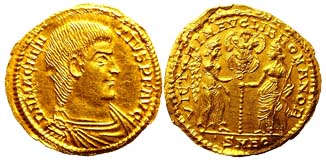
Magnentius' coinage reflects the hard economics that the usurper had to
confront. At the start of his reign, precious metals were struck at their full weight, but
it was soon necessary to reduce them. In the case of the solidus, the average weight was
around 3.84 g. Magnentius inherited the billon coinage system of Constans, who had struck
large AE2 denominations, and he maintained the weight of these coins, but they had little
or no silver content. For some reason, not much billon was struck outside of Italy from
mid-350 until the latter half of 351. The presence of the letters A or N, placed behind
the obverse portrait (and sometimes appearing on the reverse), on AE2 size coins tends to
suggest they denote value.

During the first four or five months of his reign, the obverse legend of
Magnentius' coinage employed an archaic form of title: IM CAE MAGNENTIVS AVG. The
bare-headed portrait is even more of a surprise, especially since the lack of a diadem was
characteristic of the rank of Caesar, as with Constantius Gallus' portraits. A bare-headed
emperor had not been portrayed with such frequency since the reign of Marcus Aurelius.
Although coin portraits of Magnentius wearing a diadem exist (struck at Amiens and Lyon),
it almost appears that he was reluctant to be depicted wearing one.
In Rome, Magnentius assigned three officinae (P, B and T) to strike coins
in the name of Constantius, and a series of bronze medallions were struck honoring both
emperors. Only Rome, Arles and Aquileia issued coins for Constantius. After the death of
Nepotian, Magnentius assumed the D N obverse legend replacing IMP CAES, and around the
same time, the coinage in Constantius' name ceased.
The portraits of Magnentius and Decentius follow the trend in coin
portraiture set by Constantine and his sons; the likeness is more realistic, not abstract
as those of the Tetrarchs. Also typical of the period, Magnentius' portrait fills the
surface of the flan. As flan sizes became irregular there was often the partial loss of
legend. Magnentius' first coin portraits appear to be based on those of Constans. His face
is lean and his hair, in its characteristic back sweep, is worn down to the nape of the
neck. His portrait was corrected to show heavy features (as is the case with Decentius),
full and fleshy, with a pronounced double chin. His square-jawed, determined appearance
makes him seem very formidable. Toward the end of his reign, many coin portraits show
Magnentius and Decentius heavier still. The portraits of the brothers exhibit only slight
differences; they can be difficult to tell apart without clear legends.
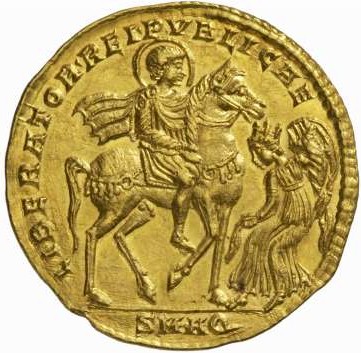
Aquileia, being the chosen outpost of Magnentius, issued coins and
medallions of particular significance. An early solidus with the legend FL MAGNENTIVS
TR(IVMPHATOR) AVG could have been initiated by an early visit to the city. Magnentius may
have assumed the consulship there on January 1, 351, as evidenced by medallions depicting
the emperor in consular robes and reverse legends of LIBERATOR REIPVBLICAE and VIRVS
AVGVSTI NOSTRI. One of these, a magnificent 3 solidi medallion was struck at Aquileia to
mark the arrival of Magnentius to the city. The reverse depicts the emperor on horseback,
extending his right arm to a female figure, in an attitude of submission, holding a
cornucopia and wearing a turreted crown. This figure has been identified as the Roman
Empire submitting to Magnentius, but the turreted crown can denote a city, and hence
Aquileia itself. [1]
Amiens was established as a mint about mid-350, perhaps using personnel
transferred from Trier. The honor paid to the city has helped support the idea that Amiens
was the birthplace of Magnentius. Only base metal coins were struck at this mint, the
earliest showing Magnentius with a diadem. Oddly, there are few issues for Decentius from
Amiens. After striking for Constantius Gallus, the mint was closed in 354.
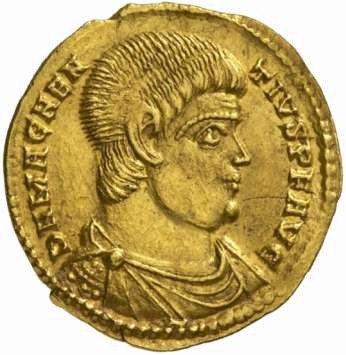
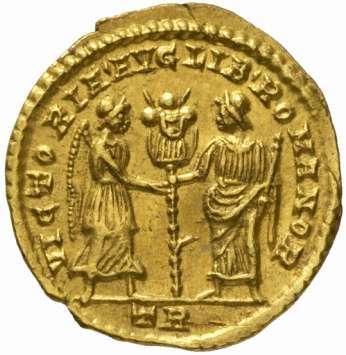
Major Types:
Magnentius' operating mints: Amiens, Arles, Aquileia, Lyon, Rome, Trier,
Siscia (August - September 351).
FEL TEMP REPARTIO:

Magnentius took over the FEL TEMP REPARTIO series from Constans, which had
been part of the reform of 346 by Constans and Constantius. This type was not struck at
Rome.
FELICITAS REPUBLICE:
Another type inherited from Constans. This reverse was struck at Gallic
mints only.
GLORIA ROMANORVM:

This was the first new reverse type issued by the new regime and was
struck by all mints, including the newly established Amiens mint. Magnentius struck a
variation of this reverse in Rome for Constantius showing the enemy soldier wearing a
Phrygian cap. This type was the primary issue of Nepotian. It ceased in Rome by mid-350
and at other mints, with a gradual decrease in flan size, during 351.
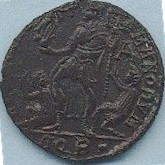
VICTORIA AVG LIB ROMANOR:
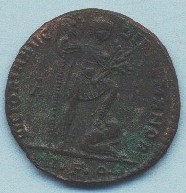
This type was struck only in Rome prior to the rebellion of Nepotian.
VRBS ROMA:
Nepotian struck this type during his brief time in power. Magnentius
retained it for himself and the type was struck until his evacuation of Italy in 352.
RENOBATIO VRBIS ROME:
A new type struck only at Rome following the recapture of the city by
Magnentius. It was struck until the evacuation of Italy.
VICTORIA AVG ET CAES:
Struck only at Siscia during Magnentius' brief occupation of the city
(August - September 351). The coins of this mint are of a lower average weight than other
mints. This type slightly antedates the better-known Two Victories type.
VICT(ORIAE) DD NN AVG ET CAE(S):
There are three variations of this type:

1.A column supports the shield/wreath held by the victories.

2.The shield/wreath is held by the victories without a column.
3.The vota wreath/shield is surmounted by a Christogram.
Struck in Italy and Gaul, this type, and its widely disseminated variants,
ceased in September 352, following Magnentius' evacuation of Italy.
SALVS DD NN AVG ET CAES (Welfare of Augustus and Caesar):
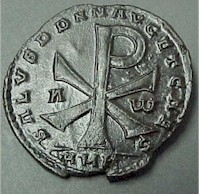
This type was struck at four Gallic mints beginning in the summer of 352
until the end of Magnentius' reign. The first issues of the double centenionalis weighed
an average of 8.33g. (AE1-- 27-28 mm) but was soon reduced to an average of 6.67g.
(reduced AE1-- 23-25 mm). A centenionalis (majorina) (AE2--20-21 mm) was issued at an
average of 4.46g. The revolt of Trier brought with it a new coin of Constantius based on
this final type of Magnentius, with the reverse legend SALVS AVG NOSTRI (Welfare of our
Augustus) and was issued at a weight of 6.00g. (A solidus was also issued with a reverse
legend VICTORIA AVG NOSTRI at a weight of 4.63g.) The weight of this coin places the issue
in the middle of Magnentius' SALUS coinage. With this evidence, it seems possible that
Decentius retook Trier from the rebels. However, the difference in weight may have been
deliberate to point out the prosperity and stability of Constantius' regime to the failing
one of Magnentius, whose weight for solidii were as low as 4.12g. [2]
Conclusion
We know very little about Magnentius. [3] With the loss of Book 13
of Ammianus, we are left with ancient historians who treated the emperor briefly and
harshly. Aurelius Victor clearly preferred Constans to Magnentius, calling the latter
"savage in character, as one would expect in a barbarian" (De Caes. 41).
Julian unleashes virulent comments about Magnentius in his Panegyrii written for
Constantius. He does not even refer to Magnentius by name, calling him only "the
usurper." The future emperor declared that Magnentius was responsible for the
slaughter of innocent men and women and that so many deaths lay on his conscience he was
fearful of an avenger (Or. 1 59 B).
Julian continues that, following the battle of Mursa, Magnentius returned
to Aquileia, where he spent his time at public shows and sensual pleasures believing
himself safe from invasion (Or. 1 38 C-D). He was watching a horse race when news
was brought to him that Constantius' troops had broken through the alpine passes and, in
haste, retreated to Gaul (Or. 1 39 C-D). Having returned to his fatherland,
Magnentius invented brutal tortures, taking pleasure in watching the sufferings of his
victims. A favorite method was to bind people to chariots, then have the teams gallop (Or.
1 40A). [4] While one cannot rule out the possibility of a cruel streak in Magnentius, it
is apparent that his character has been stereotyped: all barbarians are brutal, uncouth
and savage. Such a discriminatory belief provided Constantius with additional
justification for not compromising with his rival.
In addition to his brutal nature, Magnentius is said to have been
incompetent as a battlefield commander and cowardly. This is contrary to his reputation
prior to becoming emperor, when, because of his abilities, he rose to the rank of comes
and commanded the best legions. The battle of Mursa tends to prove he
was not as incompetent as Julian suggests. Clearly, the battle was hard-fought and
Constantius triumphed only by force of numbers, rather than Magnentius being
out-generaled. The defection of Silvanus handicapped Magnentius with the loss of a large
portion, if not all, of his cavalry.
Zosimus says Magnentius was
bold when Fortune smiled on him and a coward when she did not. He was skillful in hiding
his bad nature so people thought he was good and never did anything that was good unless
it benefited himself (2.42.1). However, Zosimus complained that people were saying good
things about Magnentius. Although it is not known about whom Zosimus was referring
Libanius and, surprisingly, Julian made such references. Libanius says that Magnentius
governed with regard for law and order (Or. 18.33). Julian paid Magnentius a
back-handed complement when he said the usurper
had not done anything laudable though much that he achieved had the
appearance of merit (Caesars 315 D-316 A).
Although we will probably never know the whole truth about Magnentius'
character, the picture of him as an incompetent, cruel barbarian cannot be taken for the
truth. The unbiased comment of Libanius, of a just ruler, presents a side of Magnentius
that was buried under the propaganda of the victors. In the end, whatever intentions
Magnentius may have had, good or bad, they were eclipsed on an autumn day on a field of
battle.

© David A. Wend 1999
Footnotes
1- J.P.C. Kent,Roman Imperial Coinage Volume VIII(London 1981),309-12.
2- J.P.C. Kent,ibid.,132-7.
3 - However, lack of information was more of an advantage when I wrote a fictious account of Magnentius.
4 - In an even greater exaggeration, Juliuan praises Constantius for having done nothing against Magnentius’ supporters unless they were guilty of other crimes (Or. 2.96A).
Bibliography
Aurelius Victor, De Caesaribus, translated by H. W. Bird,
Liverpool, 1994.
Barnes, T.D.,Athanasius and Constantius: Theology and Politics in the
Constantinian Empire, Cambridge, 1993.
Bidez, J. "Amiens, ville natale de l'empereur Magnence" REA,27(1925).
Carson, R.A.G. P.V. Hill and J.P.C. Kent, Late Roman Bronze Coinage,
New York, 1989.
Eutropius, Bevarium, translated by H. W. Bird, Liverpool, 1993.
Failmezger, Victor, Revolt, war and victory as reflected by the bronze
coinage of A.D. 350-353" The Celator 7(1993).
Frakes, Robert M. "Ammianus Marcellinus and Zonarus on a Late Roman
Assassination Plot" Historia 46(1997).
Jones, A.H.M. J.R. Martindale, and J. Morris, The Prosopography of the
Later Roman Empire, Cambridge, 1971.
Kent, J.P.C. "The Revolt of Trier Against Magnentius" NC 19
(1959).
Kent, J.P.C., Roman Imperial Coins Volume VIII, London, 1981.
MacMullen, Ramsay, Christianizing the Roman Empire AD 100-400, New
Haven,1984.
Sozomen and Philostorgius, Ecclesiastical Histories, translated by
Edward Walford, London, 1855.
Zosimus, Historia nova, translated with commentary by Ronald T. Ridley,
Sydney, 1984.